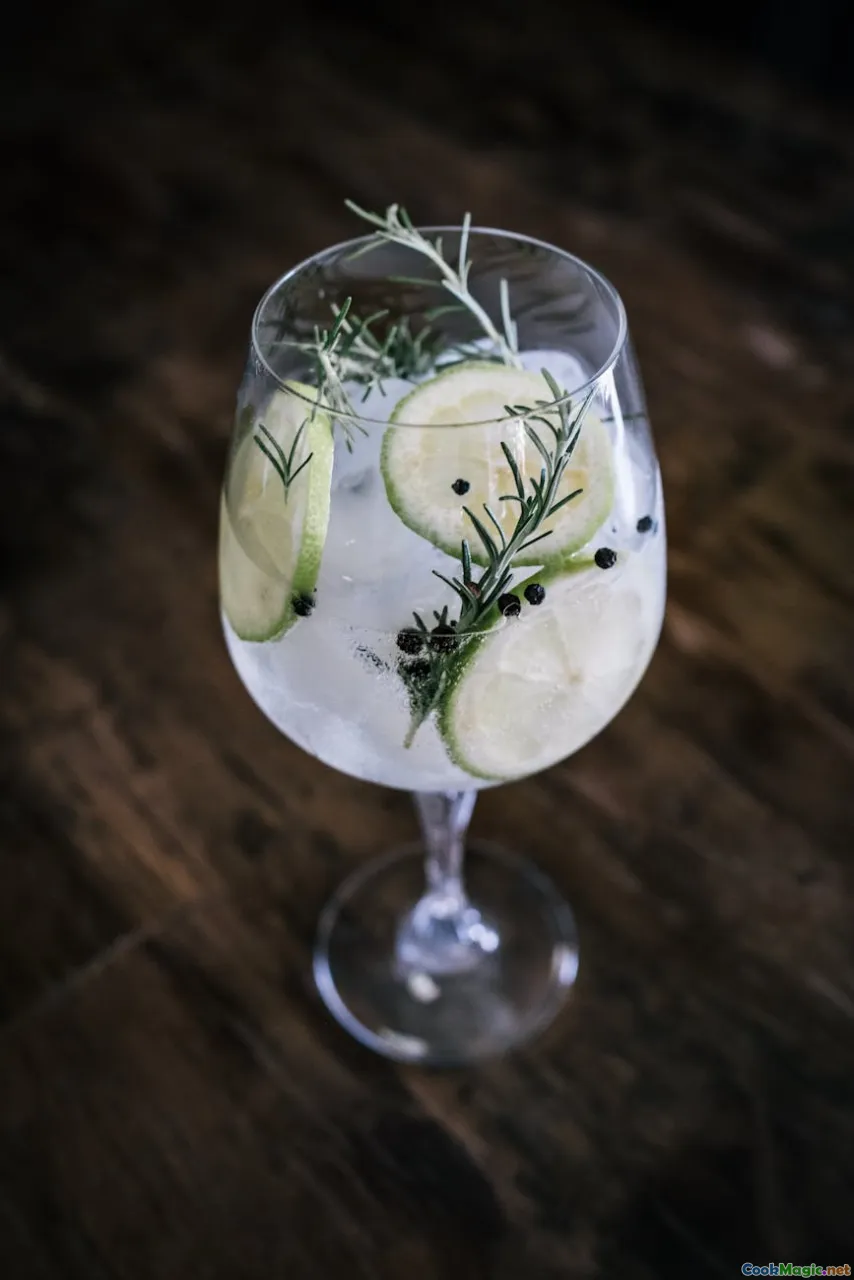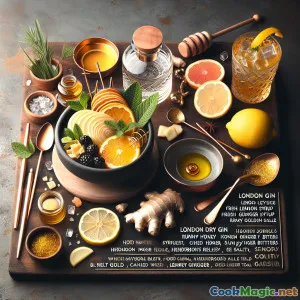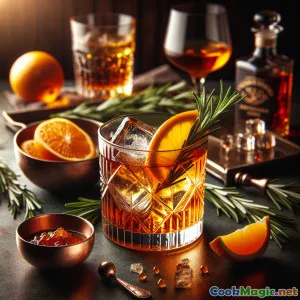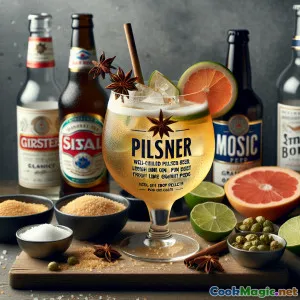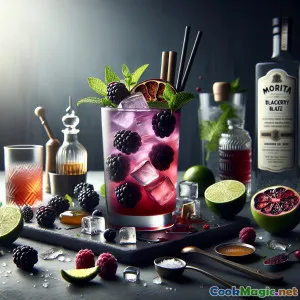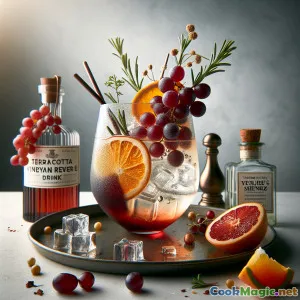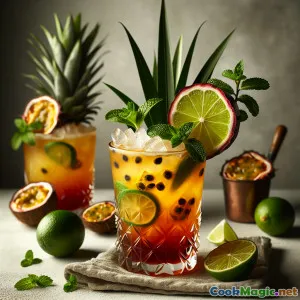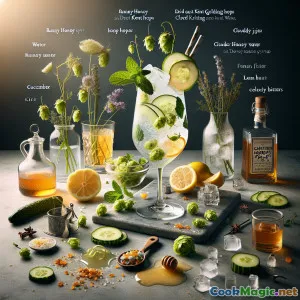
Canterbury Garden Pale : Highball anglais aux arômes de houblon
(Canterbury Garden Pale: Hop-Kissed English Highball)
(0 Avis)0
118
octobre 23, 2025
Signaler un problème
Ingrédients
-
120 ml Eau pour sirop
(For hop honey syrup base)
-
80 grams Miel liquide
(Local wildflower honey preferred; sugar works if needed)
-
2 grams Houblon East Kent Goldings séché
(Food-safe brewing hops; adjust for bitterness)
-
30 ml sirop de miel au houblon (préparé)
(From Step 1; adjust to taste)
-
100 ml London Dry Gin
(Quality English gin for botanicals)
-
40 ml Dry vermouth
(Adds herbal dryness; keep chilled)
-
60 ml Jus de pomme trouble
(Fresh-pressed if possible, for orchard sweetness)
-
250 ml eau tonique au sureau (ou eau gazeuse)
(Tonic adds floral sweetness; soda for drier finish)
-
8 slices Concombre
(Thin slices, plus extra for garnish)
-
6 leaves Feuilles de Menthe Fraîches
(Légèrement écrasé pour l'arôme)
-
2 strips Écorce de citron
(Wide strips, no pith, for garnish oils)
-
4 dashes Amers de céleri
(Bright, savory lift; orange bitters also work)
-
1 pinch Sel marin
(Enhances cucumber; use sparingly)
-
10 cubes Glace
(Gros cubes clairs préférés)
(For hop honey syrup base)
(Local wildflower honey preferred; sugar works if needed)
(Food-safe brewing hops; adjust for bitterness)
(From Step 1; adjust to taste)
(Quality English gin for botanicals)
(Adds herbal dryness; keep chilled)
(Fresh-pressed if possible, for orchard sweetness)
(Tonic adds floral sweetness; soda for drier finish)
(Thin slices, plus extra for garnish)
(Légèrement écrasé pour l'arôme)
(Wide strips, no pith, for garnish oils)
(Bright, savory lift; orange bitters also work)
(Enhances cucumber; use sparingly)
(Gros cubes clairs préférés)
Nutrition
- Portions: 2
- Taille de portion: 1 highball (250 ml)
- Calories: 220 kcal
- Carbohydrates: 0 g
- Protein: 0.3 g
- Fat: 0 g
- Fiber: 0.2 g
- Sugar: 19 g
- Sodium: 20 mg
- Cholesterol: 0 mg
- Calcium: 15 mg
- Iron: 0.2 mg
Instructions
-
1 - Make hop honey syrup:
Warm water and honey in a small pot over low heat, stirring until dissolved (do not boil). Add hops, remove from heat, cover, and steep 5 minutes. Strain through a fine mesh or coffee filter into a clean jar; chill.
-
2 - Prep glassware and garnishes:
Chill two highball glasses. Slice cucumber thinly, bruise mint leaves gently between your palms, and cut two wide lemon peels. Fill glasses with fresh ice.
-
3 - Build the Base:
In a shaker, add cucumber slices, mint, and a pinch of sea salt. Gently press (do not mash) to express oils. Add gin, dry vermouth, apple juice, hop honey syrup, and celery bitters. Add ice and shake briefly (8–10 seconds).
-
4 - Strain and lengthen:
Double-strain into the prepared highballs over fresh ice to remove hop and cucumber bits. Top each evenly with chilled elderflower tonic (or soda) and give a gentle lift with a bar spoon to combine.
-
5 - Garnish and Serve:
Express lemon peel over each glass and place as garnish alongside a cucumber ribbon or wheel. Serve immediately while effervescent and aromatic.
Warm water and honey in a small pot over low heat, stirring until dissolved (do not boil). Add hops, remove from heat, cover, and steep 5 minutes. Strain through a fine mesh or coffee filter into a clean jar; chill.
Chill two highball glasses. Slice cucumber thinly, bruise mint leaves gently between your palms, and cut two wide lemon peels. Fill glasses with fresh ice.
In a shaker, add cucumber slices, mint, and a pinch of sea salt. Gently press (do not mash) to express oils. Add gin, dry vermouth, apple juice, hop honey syrup, and celery bitters. Add ice and shake briefly (8–10 seconds).
Double-strain into the prepared highballs over fresh ice to remove hop and cucumber bits. Top each evenly with chilled elderflower tonic (or soda) and give a gentle lift with a bar spoon to combine.
Express lemon peel over each glass and place as garnish alongside a cucumber ribbon or wheel. Serve immediately while effervescent and aromatic.
En savoir plus sur: Canterbury Garden Pale : Highball anglais aux arômes de houblon
Story and Inspiration
Canterbury Garden Pale is a toast to Kent—the English county famed for Canterbury Cathedral and centuries of hop cultivation. The drink leans into the pale, orchard-fresh sensibilities of the English countryside: crisp cucumber, mint, and lemon lifted by a delicate hop honey syrup made with East Kent Goldings (EKG). Rather than using beer directly, the recipe borrows the soul of a pale ale—its floral bitterness and hedgerow nuance—by infusing that character into a refined highball. It drinks like a breezy garden party in late spring: refreshing, gently bitter, and delightfully aromatic.
Flavor Profile
Expect a luminous, straw-pale hue with a bouquet of juniper, elderflower, and green garden notes. The first sip lands bright and clean: cucumber and mint roll across the palate, followed by orchard sweetness from apple and honey. The EKG hops add a graceful bitterness that never overwhelms—more meadow than pine—and the dry vermouth ties it together with a lightly herbal, vinous spine. The finish lingers dry and refreshing, with lemon oils and tonic bubbles keeping everything lifted.
Ingredient Spotlight
- East Kent Goldings Hops: A quintessential British hop variety known for soft florals, tea-like earthiness, and gentle spice. It supplies sophistication rather than brute bitterness.
- London Dry Gin: Choose a balanced, juniper-forward gin. Its botanicals harmonize with the hop’s florals and the vermouth’s herbs.
- Dry Vermouth: Adds dryness and structure, taming sweetness while amplifying herbal complexity.
- Cloudy Apple Juice: A whisper of orchard fruit that nods to Kent’s apple heritage and smooths the hop’s edges.
- Elderflower Tonic: Floral and lightly sweet; use soda water if you prefer a drier finish.
Technique Tips and Notes
- Control Bitterness: Keep the syrup below a simmer; boiling hops can introduce harsh, tannic bitterness. A 5-minute covered steep is enough to capture aroma and a gentle bite.
- Double-Strain: Cucumber pulp and hop flecks can cloud the drink. A fine mesh plus a tea strainer gives a polished, sparkling presentation.
- Balance to Taste: Swap elderflower tonic for soda water if sweetness is high, or increase syrup by 5–10 ml if you want a fuller, honeyed profile.
- Ice Matters: Large, clear cubes dilute slowly and maintain effervescence. Replenish ice if it’s melting before service.
- Garnish Oils: Express lemon peel over the glass to lay citrus oils across the surface; it brightens the hop aromatics wonderfully.
- Make-Ahead: The hop honey syrup keeps 10–14 days refrigerated. Label with date and shake before use. For a vegan option, make a 1:1 white sugar syrup and infuse with hops the same way.
Variations
- Garden Shandy Pale: Replace the elderflower tonic with a dry English pale ale or a light lager. Stir gently, as carbonation will spike. Reduce hop syrup by 5 ml to avoid over-bittering.
- Canterbury Orchard: Swap cloudy apple juice for pear nectar and add a rosemary sprig during the light muddle for an autumnal twist.
- Citra Garden (Modern Hop): For a brighter citrus note, infuse the syrup with a tiny pinch of Citra hops mixed with EKG (use sparingly—Citra is punchier).
- Low/No Alcohol: Use a quality non-alcoholic gin and a splash of verjus in place of vermouth. The hop syrup still delivers depth; keep elderflower tonic for lift.
Cultural Significance
Kent’s hop fields shaped Britain’s brewing heritage, and Canterbury sits at the heart of that story. East Kent Goldings, historically prized by British brewers, embodies an elegant, tea-like bitterness that pairs beautifully with gin’s botanical tradition. This drink celebrates those intertwined legacies—beer’s history and gin’s renaissance—without simply pouring beer into a glass. It offers a contemporary, culinary nod to place and season.
Serving and Pairing
Serve in a chilled highball with a cucumber ribbon and a lemon twist. It pairs gracefully with soft cheeses, smoked trout, cucumber sandwiches, herb-roasted chicken, or a crisp apple and celery salad. The drink’s subtle bitterness refreshes the palate and complements herbal dishes.
Scaling and Batch Prep
For a party, pre-batch the shaken portion (gin, vermouth, apple juice, and hop syrup) in a bottle and chill thoroughly. When serving, pour 90–100 ml per glass over ice, top with cold tonic, and garnish. Avoid batching with tonic to preserve carbonation.
Final Thoughts
Canterbury Garden Pale captures the elegance of an English garden and the lineage of Kentish hops in one sparkling sip. It’s familiar yet distinctive, delicate yet characterful—an ideal highball for sunny afternoons and refined gatherings alike.

